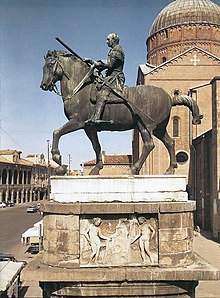The Statue and the Bust

The Statue and the Bust – poemat dziewiętnastowiecznego angielskiego poety Roberta Browninga, ogłoszony w 1855 w tomiku Men and Women[1][2].
Forma[edytuj | edytuj kod]
Wiersz Browninga jest napisany tercyną[3][4], czyli strofą trójwersową pochodzenia włoskiego, rymowaną aba bcb cdc..., spopularyzowaną przez Dantego Alighieri[5][6].
- There’s a palace in Florence, the world knows well,
- And a statue watches it from the square,
- And this story of both do our townsmen tell.
- Ages ago, a lady there,
- At the farthest window facing the East
- Asked, “Who rides by with the royal air?”
- The bridesmaids’ prattle around her ceased;
- She leaned forth, one on either hand;
- They saw how the blush of the bride increased —
Poemat Browninga charakteryzuje się oryginalną metryką. Zazwyczaj tercyna (we Włoszech układana jedenastozgłoskowcem (endecasillabo))[7] w literaturze angielskiej składa się z wersów jambicznych pięciostopowych. U Browninga natomiast wersy nie są jambiczne pięciostopowe, ale czteroakcentowe[8], jambiczno-anapestyczne. O odejściu poety od modelu pięciostopowego jambu w kierunku wiersza trójkowego (anapestycznego) pisała Julia Parker Dabney[9]. Uczona zauważa, że rozluźnienie metrycznych rygorów pięciomiarowego jambu zaowocowało "wspaniałym efektem muzycznym" ("excellent musical effect"). Browning posługuje się też aliteracją: fine/With flowers and fruits which leaves enlace; For the Duke on the lady a kiss conferred,/As the courtly custom was of yore; One day, as the lady saw her youth/Depart, and the silver thread that streaked/Her hair, and, worn by the serpent’s tooth.
Treść[edytuj | edytuj kod]
Poemat Browninga był uznany za kontrowersyjny. Przedstawia on miłość uważaną za występną. Opowiada o młodej dziewczynie, która w dniu swojego ślubu zakochała się w księciu Ferdynandzie[10]. Książę był obecny na weselu. Mąż, nazwiskiem Riccardi, podsłuchał ich rozmowę i dlatego postanowił dożywotnio uwięzić żonę w jej pokoju[10].
- In a minute can lovers exchange a word?
- If a word did pass, which I do not think,
- Only one out of the thousand heard.
- That was the bridegroom. At day’s brink
- He and his bride were alone at last
- In a bedchamber by a taper’s blink.
- Calmly he said that her lot was cast,
- That the door she had passed was shut on her
- Till the final catafalk repassed.
Tytułowe pomnik i popiersie, zamówione z osobna przez bohaterów, miały się stać jedyną pamiątka po ich niespełnionej miłości. Brak informacji o polskim przekładzie omawianego wiersza.
Przypisy[edytuj | edytuj kod]
- ↑ Men and Women Summary. enotes.com. [dostęp 2017-02-07]. (ang.).
- ↑ Robert Browning: Men and Women. Archive.org, 1902. [dostęp 2017-02-07]. (ang.).
- ↑ Jacek Baluch, Piotr Gierowski: Czesko-polski słownik terminów literackich. Kraków: Wydawnictwo Uniwersytetu Jagiellońskiego, 2016, s. 380. ISBN 978-83-233-4066-9.
- ↑ Michał Głowiński, Teresa Kostkiewiczowa, Aleksandra Okopień-Sławińska, Janusz Sławiński: Słownik terminów literackich. Wrocław: Ossolineum, 2002, s. 581. ISBN 83-04-04615-6.
- ↑ Claudio Ciociola: terza rima. treccani.it. [dostęp 2017-02-07]. (wł.).
- ↑ Terza rima. PoetryFoundation.org. [dostęp 2017-02-07]. (ang.).
- ↑ Claudio Ciociola: Endecasillabo. treccani.it. [dostęp 2017-02-07]. (wł.).
- ↑ Arthur Beatty: Browning's Verse Form: its Organic Character. Archive.org, 37. [dostęp 2017-02-07]. (ang.).
- ↑ Julia Parker Dabney: The Musical Basis of Verse, a Scientific Study of the Principles of Poetic Composition. Archive.org, 1901. s. 180-181. [dostęp 2017-02-07]. (ang.).
- ↑ a b J. Khalil: Love as Seen in Selected Poems of Robert Browning. umu.diva-portal.org. [dostęp 2017-02-07]. (ang.).
Bibliografia[edytuj | edytuj kod]
- Prentiss Cummings: The Statue and the Bust, of Browning and Other Papers Read Before The Boston Browning Society and The Brookline Thursday Club. Archive.org, 1915. [dostęp 2017-02-07]. (ang.).
- Lawrence Poston: Counter and Coin: Form as Meaning in "The Statue and the Bust". jstor.org, 1983. [dostęp 2017-02-07]. (ang.).
- W. O. Raymond: Browning’s “The Statue and The Bust”. muse.jhu.edu, 1959. [dostęp 2017-02-07]. (ang.).
Linki zewnętrzne[edytuj | edytuj kod]
- Robert Browning: The Statue and the Bust. ebooks.adelaide.edu.au. [dostęp 2017-02-07]. [zarchiwizowane z tego adresu (2017-02-08)]. (ang.).
- Robert Browning: The Statue and the Bust. Bartleby.com. [dostęp 2017-02-07]. (ang.).
